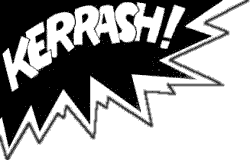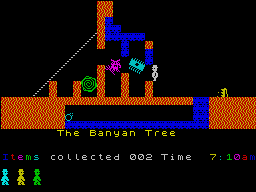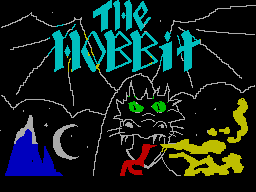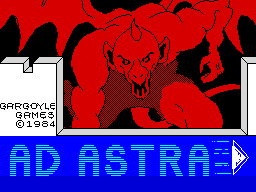Dreamers on the Increase

Software co-ordinator Paul Mee.
CRL, who call themselves ‘The Dream Makers,’ have just put two new in-house programmers to work. Paul Mee, who previously worked for an educational software house, joined the company to become the Software Development Manager in charge of the whole programming department. He began his career in computers with Hewlett Packard and has a good working knowledge of both high- and low-level languages. His function at CRL will be the co-ordination and development of new software products.

Peter Jobate — new programmer
‘CRL is a forward-looking company which, in the space of 12 months, has become one of the leading companies in its field’, said Paul. Let’s hope that Paul can look forward enough to firmly discourage the likes of Caveman and Lunar Rescue and encourage games like Omega Run. In that way the public, too, may believe that CRL is indeed a leader in its field.
The other new employee is Peter Jobate, a self-taught machine code programmer who has had programs published in books and magazines. Peter’s first new program for CRL will be released shortly. The new additions bring CRL’s total number of full-time programmers to six.
Person of the Year
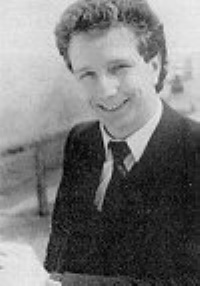
Rod Cousens
Awards within the computer industry are now really getting under way, and the only big question left to be answered is: When will we be seeing the Golden Joystick Awards presentation ceremony televised from some grand showcase centre in London? Will we see Esther Rantzen trying to elicit some gems from Matthew Smith for picking up the Best Jumper award, Seb Coe shaking paws with the Piman for winning at Olympimania or Terry Wogan congratulating Chris Urquhart for having backed the best hunch in history?
But while plans for next year’s great event go ahead, the CTA (Computer Trade Association) has voted Rod Cousens of Quicksilva ‘Person of the Year.’ Rod received the award primarily because of his work in promoting the UK software industry. In his capacity as vice-chairman of GOSH (Guild of Software Houses), Rod has been active throughout 1983 in his efforts to fight tape piracy and protect consumers’ interests. On a more serious note, judging by our picture of Rod from the last issue it looks as though he’s also aiming to pick up the award next year for ‘Best Dressed Person of the Year.’
Jet Set Willy in Multiple Deaths
We have had a number of enquiries from people asking why their Jet Set Willy programs have behaved oddly. In fact there is no real problem and the program has not crashed when you suddenly lose all those valuable lives at one go. Unlike Manic Miner, Jet Set Willy is more of an arcade adventure with random elements built in, objects and hazards may move around. The worst obstacle is a visit to the Attic. Your very presence there will cause a chain reaction in the Chapel. The four guardians from there will go to the Kitchen, West of Kitchen, Cuckoo’s Nest and the East Wall Base, making short cuts through them impossible as you will encounter instant death when entering the rooms.
Software Projects, however, have offered an apology over the fact that the program requires reloading at the end of the game after visiting the Attic. This is due to the complexity of the game and the sheer size of the program needed to generate the 60 screens.
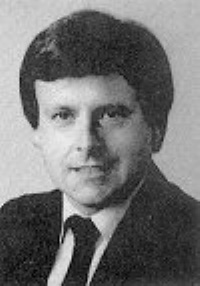
Colin Stokes
Software Project’s Colin Stokes who recently joined the company, having left Imagine, where he was Sales Manager, has had a busy time recently what with the rush over Jet Set Willy. Now he has had to look into Thrusta and Push Off, both advertised as 16K games. it would appear that they were 16K except that somewhere an odd byte has crept in and made it impossible to load either game into a 16K Spectrum. The CRASH technical department lowered RAMTOP on one of our 48K Spectrums to simulate a 16K Spectrum and tried loading without luck. Colin Stokes was very prompt in ringing back to say that it appeared to be the case, and that Software Projects would be changing the cassette inlays as soon as possible. Of course this has only been a problem for 16K Spectrum owners.

Different as chalk from cheese — the new Complex Forest map.
More Forest
If you have been wandering (or even orienteering) around Phipps Associates’s Forest you may have wandered off the edge of mapped territory or even wondered about the beyond. Now a detailed map is available for the much more complex forest which lies somewhere in the program. The new territory is as different from the first as chalk is from cheese. Giant fjords and lakes have appeared and steep-sided valleys, and even a small wooded island in the middle of the largest lake. This scenery is more like that found in Scandinavia, the home of the sport of orienteering. Like The Forest map, the Complex Forest map is a 1:10000 scale with 5m contours and has a 12-point orienteering course ready marked.
An amazing fact about the program The Forest is that 5,600 square kilometres of territory have been fitted into the 48K memory. The existing Forest map, which comes with the program, covers only two square kilometres. Similarly, the newly published map of the complex forest covers another two square kilometres. So there’s still plenty left for the intrepid explorer to do and who knows maybe there’s some forgotten tribe lost somewhere in those blank kilometres.
The new map is available only by mail order from Phipps Associates, and costs 85 pence. The Forest program and basic map costs £9.95 from computer shops anywhere and CRASH Mail Order.
Stonked Out
Further along the Mersey Imagine seem to have still been having trouble with their game Stonkers which crashes after a few minutes’ play. This was said to be a fault on some of the first batch back from duplication, but later batches still suffered with the problem. Imagine have told us that the hitch has been put right, but, once again, our last batch of tapes still seemed reluctant to Stonk for more than a few minutes. Imagine will, of course, replace any faulty tapes, so If you are having problems we suggest you send them back. Obviously lots of games are working fine, however, as Stonkers now stands at 28 in the CRASH HOTLINE.
Playing the Game
For all adventurers who prefer to remain in Tolkien’s Middle Earth rather than come up to the late nineteenth century of Sherlock Homes or the early twentieth of Mugsy, Melbourne House have published a new book called A Guide to Playing the Hobbit.
The Hobbit, winner of the Golden Joystick Award for Strategy Game of the Year 1983, is still regarded by thousands as one of the best ever adventures, but the complexities of the game have baffled as many. Now with this book, claim Melbourne House, anyone from beginner to advanced adventurer will be able to improve their understanding of the game.
A Guide to Playing the Hobbit is divided into three sections. The first aims to give a broad outline as to general strategies and tactics involved, while sections two and three give an increasing amount of guidance offering more detailed solutions to problems the player may encounter. The book has been written in such a way, however, that it should not spoil the fun and challenge of the adventure. It does not supply the solution to The Hobbit — it only offers one of many possibilities.
A Guide to Playing the Hobbit is written by David Elkan and costs £3.95. It is available from most good bookshops.
Game Keeper for the Autumn
The Game Keeper, Birmingham’s largest computer software stockist, has decided to pull out of the hardware market and restrict itself to software and accessories. The reason given for this decision is the totally inadequate supply of computers from manufacturers in Britain, making it financially not worth while to sell major lines. In a sharp rebuke, Tony Noble, Game Keeper’s managing director, says, ‘It is ironic that in a time when Clive Sinclair is announcing to the Press that computer dealers are unable to deal with volume sales that The Game Keeper has had to stop selling computers because companies like Sinclair have supplied zero stock this year. The Game Keeper needs to obtain units in excess of 500 computers a week from manufacturers and the manufacturers are totally unable to supply in such volume.’
The Game Keeper has three shops in Birmingham and one in Coventry. Now they are planning to open a network of software specialist outlets stocking games for Spectrum, Commodore and BBC computers. At the same time some 15 freelance writers are preparing new software titles for various machines to be released in the autumn under The Game Keeper software title.
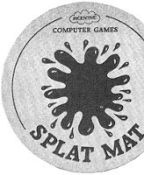
Splat Mats
Incentive Software Ltd have come up with the ideal peripheral for your Spectrum — something on which to stand that glass of beer, Coke or mug of tea. It’s a ‘Splat Mat’. For owners of the game Splat! the device printed on the centre of the beer mat will be familiar. For those sadly uninitiated Splatterites, it probably just looks like the thing it’s supposed to stop!
Splat Mats are available from Incentive Software, and they’re free on request with a stamped addressed envelope.
Spectrum for Cablevision
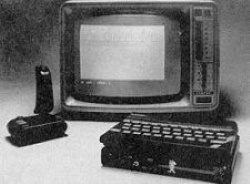
The Gamestar subscriber package includes Spectrum (48K), black box and joystick. By courtesy of British Telecom.
Cable Interactive Services (CIS), a division of British Telecom, has won the first contract to supply TV video games to a UK cable operator. The contract is with Rediffusion and is for the CIS Gamestar service. Up to one million homes on Rediffusion networks throughout the country will be able to access Gamestar, starting this summer.
Customers subscribe to Gamestar and receive a home terminal allowing them to load telesoftware down a cable and have any number of plays of a game. The cost is £9.95 a month and for this you receive hardware consisting of a 48K Spectrum with an add-on box providing joystick facilities. The black box, with its Gamestar logo, sits neatly underneath the Spectrum, connects to the computer and interfaces with the cable system. It contains an amplified speaker, to get around the Spectrum’s abysmal lack of sound. A joystick will be included as standard. The black box contains enough memory to offer a ‘welcome’ when switched on and download a menu of games on offer.
Gamestar will offer a mix of up to 20 games, ranging from arcade through to adventure and educational games, and it will be replacing five every month. Most games are envisaged as being supplied by established existing software houses, although there will be scope for new software, especially as the system grows. At any time, of course, the Spectrum may be used in the normal way for playing games or computing.
In addition to the service, subscribers will also receive a monthly newsletter magazine giving details of current and forthcoming programs as well as offering subscribers the opportunity to air their views on the games. Areas likely to be able to receive the Gamestar service are: Bargoed/Penybryn, Barrow, Basildon, Brighton/Hove, Bristol, Burnley, Darlington, Deal, Dover, Exeter, Folkestone, Grimsby, Nottingham, Oxford, Plymouth, Portadawe, Reading, Rhondda, Rotherham, Southampton, South Tyneside, Stockton (including Billingham), Stoke-on-Trent, Swansea, additions; Hartlepool, Hull, Lancaster/Kendal, Maidstone, Mansfield, Newbridge, Newport, Newcastle-upon-Tyne, Norwich, Wirral MBC, Wolverhampton, Worcester.
New Interface
Ram Electronics, the games hardware specialists, have added the Ram Turbo multi-purpose interface to its range of Spectrum compatible products. The object of the new interface, which plugs straight into any Spectrum, is to provide the user with a wide variety of interfaces. While tape software remains an option, games players may now take advantage of ROM cartridge software and connect the Microdrive and other peripherals via the full expansion port at the rear of the unit. Kempston and Protek protocols are supported by the Ram Turbo as well as the rapid fire Quickshot II.
A built-in safety device stops the user from causing expensive damage to the computer as the power cable to the Spectrum can only be connected after the interface is in place.
Ram Electronic’s technical director, Martin Shoebridge, says, ‘Technically it’s miles ahead of any competitors, but it may be the 24-hour despatch that turns out to be its biggest selling point.’
The Ram Turbo costs £22.95 on mail order plus £1 for postage and packing (£3 pp for overseas), and is available from Ram Electronics (Fleet) Ltd.
Chris Joins Ocean
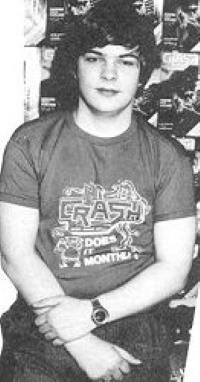
Chris Urquhart — an ambition fulfilled.
Seventeen-year-old Christian Urquhart, who co-wrote Ocean’s very successful game Transversion, has now joined Ocean’s team of in-house programmers in Manchester. Chris was first byten by the computer bug when he set eyes on an IBM mini-computer in 1976.
Says Chris nostalgically, ‘It was in Abu Dhabi — my dad was working there at the time, and he arranged for me to see it in action.’
Ever since then he has dreamt of becoming a programmer. But his first real introduction to computer games came through his friend Nick Pierpoint. They live opposite each other in Wallasey on Merseyside, but during term-time Chris was away at boarding school in Wales. During the school holidays Nick demonstrated his new 48K Spectrum to Chris, and, impressed by what he saw, Chris decided to teach himself programming.
Together they decided to write a game as a programming exercise. The ‘exercise’ was Transversion, and they concluded it wasn’t too bad for a first attempt. Encouraged by friends, who said it was just as good as games already on the market, Chris and Nick approached Ocean Software. ‘We did telephone some other software houses, but they suggested sending in the game, whereas John Woods of Ocean invited us to come in and see him on a Saturday,’ Nick remembers.
John Woods and David Ward of Ocean both liked the game, a few minor alterations were suggested and the game was accepted for publication. It was subsequently given a ‘highly recommended’ rating in the first issue of CRASH.
Delighted with this success, Chris and Nick decided to embark on a second adventure. Ocean equipped Nick with some hardware, and he continued his program writing at school in his spare time. At weekends they would visit Ocean to discuss progress, and to use some of the in-house programmers’ equipment. Chris claims, ‘Nick is very much an ideas person and good at design — I prefer logic and enjoy making ideas work.’
Their latest release is Eskimo Eddie, a version of the arcade original ‘Pengo’, and unusual because it features two entirely different screens (see review in this issue), unlike most other Spectrum versions. Eskimo Eddie is likely to prove a success, and will make Chris a hat-trick because he was also the author of Hunchback for Spectrum, which has done very well in the charts despite a less than rave review from CRASH, something Chris wasn’t slow to point out!
Chris wanted to leave school and concentrate full time on programming. He convinced his parents that he really wanted a programming career. Ocean offered him the chance on the understanding that his parents were agreeable.
With one ambition already satisfied, Chris has now replaced it with two more. ‘I’d really like to write a number one best-seller — and to work with an artist, animator and musician to create some fantastic game effects.’
As for Nick, he is studying hard for ‘O’ levels, but their partnership is only temporarily under wraps.
SEIDDAB EXPANSION
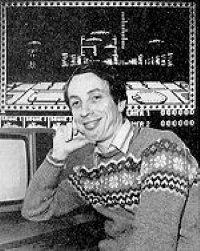
Andrew Hewson
Creators of the infernal Seiddab, Hewson Consultants, have just moved into new premises in Abingdon. It has 2,000 square feet, space enough for offices, show room and warehousing. The move has enabled them to install and run a large duplication facility. But as importantly, it will now allow them to double their staff. Already they are recruiting two in-house programmers for games finishing and conversion. The company’s growth has also been helped by the writing talents of Andrew Hewson whose book (written in conjunction with John Hardman) 40 Best Machine Code Routines for the ZX Spectrum, recently won the CTA award for the best book published in 1983.
COMPUTER GAMES ON VIDEO
It was the psychedelic communications guru of the late Sixties/early Seventies, Marshall McLuhan, who proclaimed the book and written word dead in favour of television. He was probably aware that the central weakness of his argument was the fact that all his arguments were presented in books! Twenty years later books and magazines are still the primary source of knowledge, especially in specialist fields like computers. We have, of course, seen magazines presented as computer programs, sold in cassette form, but to date television as such has been remarkably uninterested in computer games. Central Television‘s Magic Micro Mission was the first programme which actually examined the phenomenon, but now Yorkshire TV have announced that they are soon recording a series called The Game, which will be screened locally, and then, if it proves successful, will be networked later. The Game is not a programme about computer games but is in itself a computer game using a live TV audience, guest celebrities and a clever mix of video and computer game techniques.
At the time of writing, Yorkshire TV are seeking adventure, arcade and strategy game players of all ages within the Yorkshire area. Auditions are being held to see whether the entrants are up to scratch, and the really nimble fingered ones will eventually go into the studio to record the programmes.
Another departure is TV Choice‘s new video cassette, The World’s Greatest Computer Games. Claimed to be the first-ever British video devoted to computer games software, the video is 30 minutes long and puts together, ‘a collection of the highest quality and most mind-boggling computer games, shows you how to play them and highlights their imaginative features.’
Twenty-one games are featured, with Chris Tarrant, of Tiswas, OTT and TVam fame, hosting the programme. The tape starts and ends with advertisements from some of the major companies in the business, and covers games for the Commodore 64, Oric Atmos, BBC, Atari computer and VCS, and the ZX Spectrum, which Mr Tarrant refers to rather quaintly as the ‘Zed-ex.’ Among the Spectrum games, well-known programmes like Valhalla, Black Crystal and Jet Set Willy are featured.
Executive producer Norman Thomas says, ‘While there are some very good games around, the vast majority of the products at the moment on the market are absolute rubbish. This video will direct the consumer to the best games they can buy. It will allow them to sample the games before they part with their money.’
Whilst the short programme is quite entertaining, it suffers a number of faults. First and foremost it only shows 20-odd games across a range of computers, thus showing the consumer very little in his interest area. Secondly, on screen, Mr Tarrant explains that he isn’t very good at playing the games, which rather undoes the claim of the producers that the programme shows you how to play them. The third fault, or misconception, is that seeing a game on a TV screen allows the consumer to ‘sample’ it. There’s no substitute for hands-on-experience.
TV Choice have also announced their intention to release another tape which will be a computer games magazine. The intention is to critically evaluate new games on the market and back them up by interviews with the people who make the games.
The World’s Greatest Computer Games should be available for sale, rental or merely on view, in computer retail outlets.
TO THE STARS!
Birmingham, generally lagging behind Manchester and Liverpool for games programming, is now making a sterling effort to catch up. Brand new company Gargoyle Games, has launched its first game for the 48K Spectrum. It’s called Ad Astra (to the stars), and is a 3D shoot em up like you’ve never seen before. The 3D perspective view is quite astonishing — see the review in this issue.
Programs authors Greg Follis and Roy Carter have a background not only in programming, but also in art, and the graphics quality of the new game certainly points to their artistic abilities. They are now working hard on the second release which has a tentative title of Arabesque, but says Greg, this will probably be changed before the game is available. It will be an arcade style adventure and features a warrior sixty-four pixels high. The game employs full film techniques to achieve the animation effects, techniques which can also be seen to good effect in Ad Astra.
CREATIVE SPARK
At Christmas electronic giants Thorn EMI released five games for the Spectrum. But the company has been unhappy with its image as far as the games market goes, and has now rethought the matter. After some considerable brainstorming, according to Gordon Reid, Product Manager for Thorn EMI computer software, they came up with the name Creative Spark. ‘Thorn EMI is not a good idea for an entertainment brand name,’ he said, ‘and we wanted to get away from the big corporate image.’
The result is two new games for the Spectrum (reviewed in this issue) and several others for the Commodore 64, Vic 20 and Atari computers. Tower of Evil and Orc Attack for the 48K Spectrum, are very nicely packaged and retail at £6.95. Both games have been written by in-house programmers at Thorn EMI’s Wardour Street programming department. Sandy McKenzie, Manager of Home Computer Software, oversees the department, which consists of 22 in-house programmers at the moment.
The five earlier games are now being marketed by Creative Spark, but still in their original packaging, with the exception of River Rescue. This will be repackaged because it is also being released for the three other machines. Future plans for 1984 are three more releases during the year totalling eight to nine games for the Spectrum.
Gordon Reid says that they will be keeping an open mind regarding newer computers such as the QL, Amstrad and some of the Japanese machines which are soon to arrive on the market.
SUBLIMINAL
With sales of computer games slumping in America, software houses are grabbing any gimmick they can think of (better and better games don’t seem to enter into it over there). The latest craze is for psychological self-help programs, and one of the most talked about at the minute is Simutech Incorporated’s Expando-Vision. For about £80 you can buy an interface and eight programs on disk, cartridge or cassette. This package will then flash messages onto your TV screen at a claimed 1/30th of a second. At that speed, of course, the eye cannot register anything, but, so the company claims, the brain’s subconsciousness does register it subliminally, and the message has an effect.
MAIDEN IN DISTRESS
Christian Urquhart has told us that he is busy on a new game to be released by Ocean shortly. Called Cavalon, it involves a knight who must hurtle through mazes to rescue a maiden in distress. There is an evil wizard who must first be sorted out before whisking the happy maiden off to a life of bliss. There’s obviously a streak of the romantic in Mr. Urquhart who has already helped Quasimodo rescue Esmeralda in Hunchback.
THE CUB THAT DOESN’T CRAWL
At last someone has produced a reasonably priced colour monitor for use with the Spectrum computer. Microvitec first showed their Cub monitor at the March ZX Microfair, where it caused quite a stir. It is now generally available. Measuring approximately 14 inches wide by 11 high and 14 deep, the monitor comes in a black metal case which complements the Spectrum styling. The screen is 14 inches (across the diagonal). Controls are very simple. Placed at the rear is an on/off switch, a tuner and a brilliance control. A small flick switch allows you to set up for the Spectrum or to accept a video input from any other TTL compatible computer, or from a video recorder.
It might seem an expensive addition for the games player, but anyone who uses their computer regularly could hardly fail to be startled by the difference in quality between the Cub and their normal TV. The least of the improvements the Cub offers over the folly is the loss of ‘crawl.’ The colours are a great deal sharper and more saturated, and the entire display has a crystal clarity that many people may have believed impossible from the Spectrum. An additional bonus is that it should make your video tapes look splendid too, although being a monitor it obviously suffers from a lack of sound!
After a week’s trial by the CRASH reviewing team, we have decided that from now on all screen reproductions in the magazine will be photographed on the Microvitec Cub. Not all those appearing in this issue have been done on the Cub, but those that have are credited, so you can see the difference.
The Microvitec Cub is now available at most good computer retail outlets, priced £225 plus VAT.
QUICKSILVA IN AMERICA
In January of this year the Consumer Electronics Show was held in Las Vegas. Quite a number of British software houses attended the show. We asked Mark Eyles of Quicksilva, to write his impressions for us. Although the show is now long over, the effect that British software is having in America is still very much current, as Mark’s report shows.
The flight to the east coast of America takes a whole night, a long time to be flying over featureless wastes of water, the flight from the east coast to Las Vegas, near the west coast, takes the whole day. America is indeed every bit as big as Americans claim, the entire United Kingdom would be lost in a state like Texas home of Quicksilva Inc’s head offices and there are over 50 states...
Quicksilva Ltd saw the potential market in America and looked for someone to market its games, various distributors were approached and all found lacking in one way or another and so the right people were sought out to form Quicksilva Inc. a sister company to Quicksilva Ltd. They were Carl Ziegler and Roger Howard, who were found, after much searching, in Paris. They moved to San Antonio, Texas and set up Quicksilva Inc. San Antonio is at the bottom of America mid-way between the coasts and in an ideal position to service the huge continent.
Las Vegas sits in the Nevada Desert and is the gambling centre of the United States of America, gambling is illegal elsewhere in America so all the gambling is concentrated into this one crazy city. Near Las Vegas is the huge Hoover Dam which supplies virtually limitless supplies of cheap electricity which the Casinos use to turn night into day.

Mark Eyles
In Las Vegas in January 1984 the Consumer Electronics Show was held, and here Quicksilva Ltd and Quicksilva Inc gathered to start their onslaught on the American market. At a stand in one of the small halls Quicksilva unveiled its first products, Time Gate for the American Spectrum (the Timex-Sinclair 2068) and Bugaboo for the Commodore 64 were among those games on show. The small hall although small in American terms was the size of three or four Earls Courts, the main hall was of the sort of size where one would expect to see clouds forming and small tribes lost among the stands preying on unsuspecting visitors.
Also exhibiting their latest game, Hideous Bill, on the Quicksilva stand were Virgin Games, who are joining forces with Quicksilva Inc to promote themselves in the USA. The Americans were amazed, they couldn’t believe what they were seeing, for in America you will not find the variety and ingenuity that exists among British software houses, in particular the ones which insist on original games and not straight arcade copies. Not only were orders flowing in thick and fast from retailers and distributors but also exhibitors from large American games software houses were coming over to see the games, then going away and coming back with their colleagues to show them and enquire when would they be able to buy them. Quicksilva Inc had arrived after six months of painstaking preparation and America was ready for them.
The internal flights in America are like buses! The plane lands, passengers get off and new ones get on and in ten minutes the plane is flying to the next town and the pilot is saying over the speakers “Hi there, the weather’s lookin’ good so you have a nice day y’awl.” In one of these the exhibitors from the CES show flew down to San Antonio, home of Quicksilva Inc, Carl and Roger from Quicksilva Inc, Mark Eyles, Caroline Hayon and Rod Cousens from Quicksilva Ltd and Nick Alexander from Virgin Games. We watched out the window as we came in to land looking for the Quicksilva offices which are visible from the plane. We landed finally in a clear cool Texan sunset.
The following morning we arrived at the offices and started to sort out the orders and enquiries from the show. Quicksilva Inc is well established and has its own Disk Duplicating facilities, stores and functions 24 hours-a-day. Cassettes are copied by a large duplicating company a mile down the road, the covers are printed round the corner and lunchtime is spent in a Mexican restaurant with Guacamole and Nachos (these are food and not friends!)
The American market is not just bigger than the English market but it is subtly different, Americans are not keen on cassettes and where possible everything must be on Disk. Although on the Timex-Sinclair 2068 they are content to use tapes, on the Commodore 64 you couldn’t give away a program on cassette! The packaging has to be big, at least as big as video cassette boxes and preferably two or three times as big.
Computer games are sold everywhere, in fact while in America we came across Quicksilva ZX-81 games (from a distribution agreement nearly two years old) in one of the large retail chains which sprawl across America. It was an odd feeling to travel half way round the world and then find your games on a shop counter, though a satisfying one. Another interesting aspect of American marketing is that everything is bought and sold with credit cards and money is rapidly going out of fashion.
Quicksilva Inc is now going through a rapid growth phase as the Quicksilva name is becoming known throughout the USA, and Quicksilva Inc is expanding to fill a large gap in the vast American market. This growth is not without its cost though, for instance to advertise right across the USA is phenomenally expensive, adverts aren’t quite 50 times as expensive but in some periodicals nearly so, but the rewards and the promise of this growing market make it a must for Britain’s leading original games software house.
© MARK EYLES


